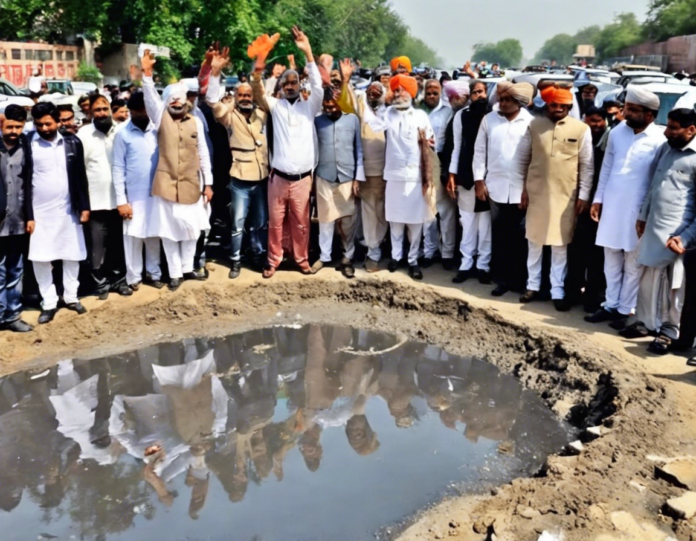Introduction
Potholes are a common nuisance that drivers around the world have to deal with on a daily basis. Not only do they cause damage to vehicles, but they also pose a serious threat to road safety. In Haryana, India, the issue of potholes recently gained national attention due to an unusual protest that took place in Gurugram. This protest, which involved a man lying down in a massive pothole to draw attention to the poor road conditions, sparked a debate about the importance of maintaining road infrastructure. In this article, we will delve into the problem of potholes in Haryana and explore potential solutions to this widespread issue.
The Pothole Problem in Haryana
Potholes are a common sight on many roads in Haryana, especially after the monsoon season when heavy rainfall can cause roads to deteriorate rapidly. Potholes form when water seeps into cracks in the road surface, freezes, expands, and then thaws, leaving behind gaps in the pavement. As vehicles drive over these weakened areas, the asphalt breaks apart, creating potholes of various sizes and depths.
The presence of potholes not only makes for a bumpy and uncomfortable ride for motorists but also poses serious safety hazards. Potholes can cause vehicles to swerve unexpectedly, leading to accidents and injuries. Moreover, they can damage vehicle tires, suspension systems, and alignments, resulting in costly repairs for drivers.
The Dead Man’s Protest
In response to the poor road conditions and in an effort to draw attention to the issue, a man in Gurugram staged a unique protest by lying down in a massive pothole on a busy road. This dramatic demonstration quickly went viral on social media, shining a spotlight on the prevalence of potholes in the region and the need for immediate action to address the problem.
The protest not only grabbed the public’s attention but also prompted local authorities to take action to fill the pothole and repair the road. While the protest may have been unconventional, it effectively highlighted the frustrations of residents who have to navigate poorly maintained roads on a daily basis.
Impact of Potholes on Society
The presence of potholes on roads can have far-reaching consequences for society as a whole. Some of the key impacts of potholes include:
– Increased accidents and injuries: Potholes create hazards for drivers, cyclists, and pedestrians, leading to an increased risk of accidents and injuries.
– Traffic congestion: Drivers often slow down or swerve to avoid potholes, causing traffic congestion and delays, especially during peak hours.
– Economic costs: Potholes can damage vehicles and result in costly repairs for individuals. They can also impact businesses by affecting transportation logistics and delivery times.
– Damage to infrastructure: Potholes are not just a surface-level issue; they can also compromise the structural integrity of roads and bridges if left unattended, leading to more extensive repairs in the future.
Solutions to the Pothole Problem
Addressing the pothole problem in Haryana requires a multi-faceted approach that involves proactive maintenance, timely repairs, and long-term infrastructure planning. Some potential solutions to combat potholes include:
– Regular inspections: Conducting regular inspections of roads to identify and repair potholes before they worsen can help prevent accidents and extend the lifespan of road surfaces.
– Proper drainage: Improving drainage systems to prevent water from pooling on roads and seeping into pavement cracks can reduce the formation of potholes.
– Quality materials: Using high-quality asphalt and other materials in road construction and maintenance can make roads more durable and resistant to wear and tear.
– Community participation: Encouraging community members to report potholes and other road hazards can help authorities prioritize repairs and address issues in a timely manner.
– Technology solutions: Implementing innovative technologies such as pothole detection sensors and road monitoring systems can help authorities identify and repair potholes more efficiently.
Conclusion
The recent Dead Man’s Protest in Haryana served as a stark reminder of the challenges posed by potholes on roads and the urgent need for improved infrastructure maintenance. By raising awareness about the impact of potholes and advocating for better road conditions, individuals can play a crucial role in prompting authorities to take action. Addressing the pothole problem requires a concerted effort from government agencies, communities, and individuals to ensure safer and smoother roads for all.
Frequently Asked Questions (FAQs)
1. What causes potholes to form on roads?
Potholes form when water seeps into cracks in the road surface, freezes, expands, and then thaws, leaving behind gaps in the pavement. As vehicles drive over these weakened areas, the asphalt breaks apart, creating potholes.
2. How do potholes affect road safety?
Potholes pose a serious threat to road safety by causing vehicles to swerve unexpectedly, leading to accidents and injuries. They can also damage vehicle tires, suspension systems, and alignments, resulting in costly repairs for drivers.
3. What are the economic costs of potholes?
Potholes can damage vehicles and result in costly repairs for individuals. They can also impact businesses by affecting transportation logistics and delivery times, leading to economic losses.
4. How can communities contribute to addressing the pothole problem?
Communities can contribute to addressing the pothole problem by reporting potholes and other road hazards to authorities, raising awareness about road safety issues, and advocating for improved infrastructure maintenance.
5. What are some long-term solutions to combat potholes?
Long-term solutions to combat potholes include regular inspections of roads, proper drainage improvements, the use of quality materials in road construction, community participation in reporting road hazards, and the implementation of technology solutions for more efficient pothole detection and repairs.












